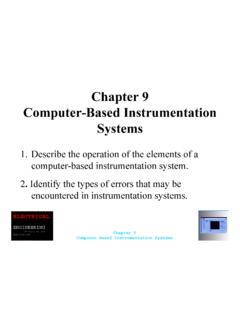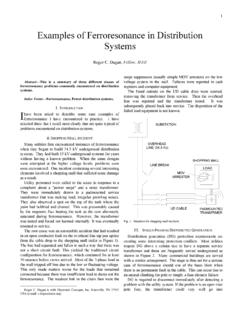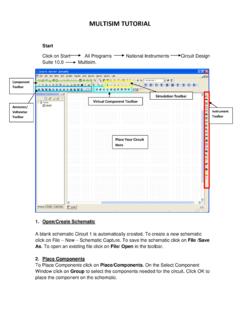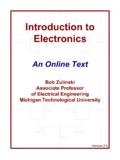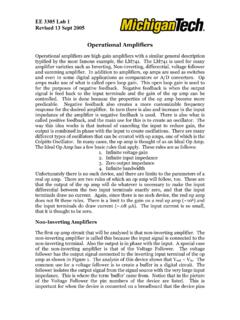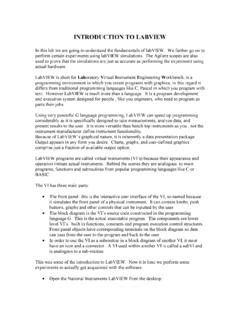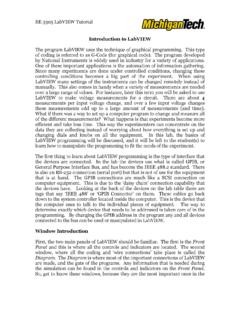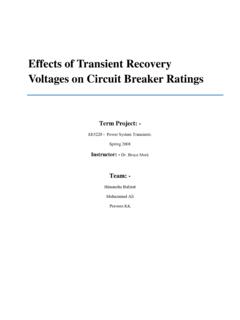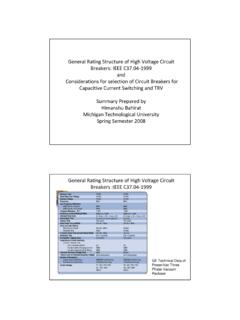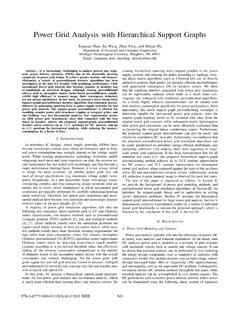Transcription of Lecture Notes EEE 360 - Michigan Technological University
1 1 SESSION 3 Short Circuit Calculations, Unsymmetrical FaultsLeonard Bohmann, Michigan State UniversityElham Makram, Clemson University2 Short Circuit CalculationsLeonard BohmannMichigan State University3 Line to Ground Short2003 IEEE T & D CONFERENCE42003 IEEE T & D (kA)Short Circuit Fault Currentshigh frequency transientdc offsetdecaying sinusoid52003 IEEE T & D CONFERENCES hort Circuit Fault Currents (continued)v(t)X(t)R]e)tcos()t[cos()t(ZV )t(ithen)t(jXR)t(Z)tcos(V)t(vif)t(XtR0mm + + =+= + = + + = XtR0me)tcos()tcos(ZV)t(i2003 IEEE T & D CONFERENCE7 Variable IEEE T & D CONFERENCE)tcos()t(ZV)t(im + =8 Reactance of Synchronous (pu)X'dX"dXd2003 IEEE T & D CONFERENCE9 Use sub-transient reactance to calculatefault currents worst case for when CB is opening Do not calculate dc offset directly use X/R to approximate offset(asymmetry ratio) at opening time X/R is the time constant of the decay incycles2003 IEEE T & D CONFERENCE10 How do youcalculate thefault current (If)at bus 3?
2 ZT12ZT351234 ZG1ZG4ZT15ZL55ZL2 IfZT23ZT342003 IEEE T & D CONFERENCE11 Use Thevenin equivalentVThZTh3If VTh: open circuitvoltage also called the pre-fault voltage, Vf oftenuse1 0 2003 IEEE T & D CONFERENCE122003 IEEE T & D CONFERENCEUse for: symmetrical faults single phase networks three phase faults in three phasenetworks (per phase equivalent) concept for solving all faults132003 IEEE T & D CONFERENCE This method calculates the currentgoing into the fault Often want the current elsewherein the network (through a circuitbreaker, in bus bars, in other lines,etc.)14A current source, with the magnitude ofthe fault current, placed at the fault, hasthe same effect on the rest of the circuitas the short IEEE T & D CONFERENCE15 Adding a current source tothe original circuit hasthe same electricaleffect as adding it tothe equivalent circuit2003 IEEE T & D CONFERENCEVfZTh3 IfZT12ZT351234 ZG1ZG4ZT23ZT15ZL55ZL2ZT34If16 All the voltages and allthe currents can be foundusing the new IEEE T & D CONFERENCEZT12ZT351234 ZG1ZG4ZT23ZT15ZL55ZL2ZT34 IfUse superposition: Use the original sources(or assume currents are 0and voltages are 1 0 ) Use just the currentsource, gives changesdue to the fault17 Calculation detailsBus Admittance Matrix.
3 Ybus2003 IEEE T & D CONFERENCEI=YbusVvector of currentinjectionsvector of busvoltagesZT12ZT351234 ZG1ZG4ZT23ZT15ZL55ZL2ZT34If182003 IEEE T & D CONFERENCEZT12ZT351234 ZG1ZG4ZT23ZT15ZL55ZL2ZT34If =555351444335343332232221151211bus000000 0000 YYYYYYYYYYYYYYYYD iagonals: of Y connected at nodeY22=1/ZT12+1/ZL2+1/ZT23 Off diagonals:- of Y connected between nodesY53=-1/ZT35192003 IEEE T & D CONFERENCEY busis sparse (lots of zero) smallsize easy to build quick algorithms to manipulate20 Bus Impedance Matrix: Zbus2003 IEEE T & D CONFERENCEV=ZbusIvector of currentinjectionsvector of busvoltagesZT12ZT351234 ZG1ZG4ZT23ZT15ZL55ZL2ZT34 IfZbus=Ybus-121 =555453525145444342413534333231252423222 11514131211busZZZZZZZZZZZZZZZZZZZZZZZZZZ 2003 IEEE T & D CONFERENCEZ busis a full matrix slowtoinvert slow to manipulate avoid using ifpossibleDiagonal element is the TheveninImpedance at that bus Z33is the Thevenin Impedance at bus 3222003 IEEE T & D CONFERENCETo find the change in voltages due tothe fault current at bus 3: = 00I-00 VVVVVf5554535251454443424135343332312524 232221151413121154321 ZZZZZZZZZZZZZZZZZZZZZZZZZ23To calculate current in line 2-3:2003 IEEE T & D CONFERENCE23T32f23 ZVVI = 1234ZT235If I23f24 Asymmetry ratio.
4 S Method calculates the RMS worst caseof the 60 Hz component this is needed to set protective relays For circuit breaker selection, need toknow the total RMS current (60 Hzand dc offset) Circuit breakers are rated on symmetricalfault current, assuming an X/R ratio of 152003 IEEE T & D CONFERENCE252003 IEEE T & D CONFERENCE()RXt2acRMSRXt2acRMS2 RXtac2acRMS2dc2acRMS21isS(t)wheretSII21 III2 IIIII += += +=+=eeeAsymmetry ratio26 Calculating X/R Equations presented arefor a single order system For higher order systems, ignore R and findequivalent X, ignore X, and findequivalent R Actual decay is typicallyquicker than thisapproximationZT12ZT351234 ZG1ZG4ZT23ZT15ZL55ZL2ZT34If2003 IEEE T & D CONFERENCE27 Algorithm2003 IEEE T & D CONFERENCE Calculate Thevenin Impedance Calculate current into fault Find the needed elements of Zbus(not allof them) Find the needed changes in bus voltages Find the line currents of of interest Find the dc offset28 Example The oneline drawing of a system, along with Zbusare shown pu1234 puj15pu5j10 pu2003 IEEE T & D CONFERENCEpuj = ) Calculate the fault current for athree phase solid fault at bus ) Calculate the voltages at bus 1,2, and 3 during this ) Calculate the current flowingfrom bus 2 to bus (i): Calculate the fault current for a threephase solid fault at bus 3.
5 Assume all initial busvoltages are 1 0 therefore all initialcurrents are 0 Use the 3,3 elementof Zbusfor theThevenin 0 IEEE T & D ==30 Multiply the negative of thefault current by elements inthe 3rdcolumn to get the change in voltages2003 IEEE T & D CONFERENCEPart (ii): Calculate the voltages at bus 2, 3, and4 during this fault. = IEEE T & D CONFERENCEPart (ii): Calculate the voltages at bus 2, 3, and4 during this fault. (continued)pupupu0101 VVV07660923001 VVV3130687001 VVV33i3f22i2f11i1f= = == = == = =..The voltages during the fault are the initial voltagesminus the changes in the voltages322003 IEEE T & D CONFERENCEPart (iii): Calculate the current flowing from bus 2to bus current is the differencebetween the voltagesdivided by the = = = pu33 Problem1234 IEEE T & D CONFERENCEA small power system is sketched below along with ) What is the fault current for a three-phase fault toground at bus 3?
6 B) What are the voltages at busses 2, 3, and 4?c) What is the current due to the fault from bus 4 to 3 andfrom 2 to 3?puj2bus1040451063422217421063658463432 61342226343534404431742261304437834Z =..12003 IEEE T & D CONFERENCEU nsymmetrical FaultsElham MakramClemson University1 SINGLE LINE TO GROUND Single line to ground fault on phase A2003 IEEE T & D CONFERENCEZfIbfIcfIafabcn0f210affa210120 21221222102120afffcfbf3I*ZVVVOr,I*ZVNowI II0Ia)a(IThusIIa)I (aa)I (a0 IaaIIaIIaIequations,currenttheFromI*ZV0 IIlocationfaultatConditionsBoundary=++== ==++===++=++===22003 IEEE T & D CONFERENCESINGLE LINE TO GROUND FAULT (CONTD.) Sequence connection for A-G faultI0To satisfy the voltage and current boundary conditions, the sequence networks should beconnected in series as shown in Fig. +-+V1-V2-+32003 IEEE T & D CONFERENCELINE TO LINE Line to line faultaZfIbfIcfIafbcnVaf+VbfVcf1f2122f121 222102120f2120bffcfbf2122122212120cfbfaf IZVVa)V-(aZa)I-(aa)V-(atoleadsThisVaaVV) aIIa(IZaVVaVIZVV conditionsboundaryVoltageI-Ia)I(a-a)I(a0 IaaIaIIa0 IThus,I-I0 IConditionsboundaryCurrent+=+=+++++=+++= =+=+=+++===42003 IEEE T & D Connection of sequence network for BC faultTo satisfy the voltage and current boundary conditions, the sequence networks shouldbe connected as shown in Fig.
7 TO LINE FAULT (CONTD.)ZfPositiveSequenceNetworkNegativ eSequenceNetworkI1I2+V1-V2-+52003 IEEE T & D CONFERENCEDOUBLE LINE TO GROUND Double line to ground fault0f10f221212021202122102120cfbffcfbf bf210afI3ZV-VThusZ)IaaIaIIa2I(aVVaVAlso, VVThusVaaVVaVVaVThus,VVand,)ZI(IVconditi onsboundaryVoltage0 IIIThus,0 Ilocation,faultat theConditionsboundaryCurrent=++++=++=++= ++=+==++=Zfabcn+IbfIcfIafVafVbfVcf62003 IEEE T & D CONFERENCEDOUBLE LINE TO GROUND FAULT (CONTD.) Sequence network connection for doubleline to ground faultConsidering the voltage and current boundary conditions, the sequence networks areconnected as shown in Fig. +-+V1-V2-+72003 IEEE T & D CONFERENCEE xample 1 Consider the power system shown in Fig. and G2: 100 MVA, 20 kVX1=X2= T2: 100 MVA, 345/20 kVXT1=XT2= puT. the voltages at Bus 1 and thecurrents from T1to P due to(i)Single line to ground fault at P(ii) Line to line fault at P(iii) Double line to ground fault at PFig.
8 7. Example 1G1G2T1T212PT. IEEE T & D CONFERENCEP ositive sequence networkNegative sequence networkZero sequence networkZ0th= ) ( || )( +++= ===92003 IEEE T & D CONFERENCE(i) Single line to ground ( ) ( )( ) )( )( :arelocationfaultat )( * ) ( )ZZ(ZEIII000222111102112th1th0th021>==== ======= =+=>=++ ++===j = a2a1a022cbaIII*11111 IIIaaaa102003 IEEE T & D 3 ( )aa( ) a( )( ) +==+=== ))( (1)( )120( ))( (1)( )240( :arelocationfaultat thevoltagesphaseThe2210c2120b210a+= + +=++== + +=++==+=++=112003 IEEE T & D CONFERENCE(ii) Line to line fault = = ===== ==+==+===> =+ => =+ =+= = )( )( ( )a( ) ( )( ) )--1T( ) ( )--1T( )( )Z(ZEII:Currentscba2a2a21a1a12c2ba212th1 th21j122003 IEEE T & D CONFERENCESEQUENCE PHASE SHIFT THROUGH WYE/DELTA TRANSFORMER BANK Positive and negative sequence impedance is independent of connection These networks ignore phase shift When current and voltages are transformed from one side to the other phase shift mustbe considered.
9 Standard ANSI connection has been shown in figs. 8 (a) and 8 (b).Fig. 8 (a) Wye/DeltaFig. 8 (b) Delta/WyeHigh sideLow sideIAIBICIaIbIcABCabcnIAnIBnICIAIBICn:1 BCAbcaHigh sideLow sideIaIbIcIAIBICabcABCIa/nIb/nIc/nn:1 BCAbca132003 IEEE T & D CONFERENCE30 VVunitperInor30V3na)-(1nV)aV-n(V)V-n(VV: voltagesequenceNegative30 IIunitperInor30I3n)a-(1nI)Ia-n(I)I-n(II: currentsequenceNegative30 VVunit,perinor30V3n)a-(1nV)Va-n(VV:volat gesequencePositive30 IIunit,perIn30-I3na)-(1nI)aI-n(I)I-n(II: currentsequencePositive8(a) toa2A2a2a2a2a2b2a2A2a2A2A22A2A22A2C2A22a a1A1a12aa12a1A1a1A1A1A1A1A1C1A11a = ==== = ==== = === = ====142003 IEEE T & D CONFERENCE = = == = == = ===30 VVvoltagesequenceNegative30 IIunitperInor30In3)aI-(In1I:currentseque nceNegative30 VVunit,perinor,30Vn3)aV-(Vn1V:voltageseq uencePostitive30 IIunit,perinor,30In3)Ia-(In1)I-(In1I:cur rentsequencePostitive(b) toa2A2a2A2a2a2a2A2a1A1A1A1A1a1a1A1a1a12a 1b1a1A1152003 IEEE T & D CONFERENCE = + = 30-voltageLowsequenceNegativegeHigh voltasequenceNegative(ii)30voltageLowseq uencePositivegeHigh voltasequencePositive(i):sconnectionY-or -Yingeneral,In162003 IEEE T & D CONFERENCEE xample 2 Find the currents and voltages at G1 of Example 1, due to single line to ground fault at )60( )120( )60-( )120-( :Currents(i)cgag2ag12bgag21agagag0ag21ag == + = + =+== + =+== = + = = =172003 IEEE T & D CONFERENCE = = =+= = =+= = =+= = ====== * )phaseneglectingNetworksequence( Vshift)phaseneglectingNetworksequence( )( )( EV:Voltages(ii)ag2ag1ag022cgbgagag22ag1c gag2ag12bgag2ag1agag2ag1g2a2ag2g1a1ag1aa aaExample 2 ( contd.)
10 182003 IEEE T & D CONFERENCEPROBLEM #1 For the system shown below, find the currents in the transformer and generator windings inper unit and amperes for a single-line-to-ground fault at(i)P(ii) RG115/115 kVPG1RG: 100 MVA, 15 kVX1=X2= ,X0= :100 MVA, 15/115 kVX= #2 Solve examples 1 and 2 for a double-line-to-ground fault at IEEE T & D CONFERENCE202003 IEEE T & D CONFERENCEPROBLEM #3 Solve examples 1 and 2 for a line-line fault at
